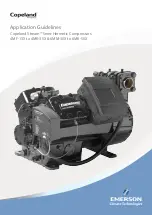
17
English
4. Remove the small plate, being careful not to drop anything
on the exposed valves.
5. Carefully lift out the air filter and screens. NOTE: The screen
edges are sharp.
6. Place cleaned or new air filter between the screens and
insert back into grooves. Refer to the Replacement Parts
under Service.
7. Place the plate back onto the pump head, insert the screws
and washers, tighten the screws.
CAUTION:
Risk of unsafe operation. Do not operate without air
filter.
Draining Air Tank (Fig. 3)
WARNING:
Risk of unsafe operation. Air tanks contain high
pressure air. Keep face and other body parts away from outlet of
drain. Use eye protection [ANSI Z87.1 (CAN/CSA Z94.3)] when
draining as debris can be kicked up into face.
WARNING:
Risk from noise. Use ear protection (ANSI S12.6
(S3.19) as air flow noise is loud when draining.
NOTE:
All compressed air systems generate condensation that accu-
mulates in any drain point (e.g., tanks, filter, aftercoolers, dryers). This
condensate contains lubricating oil and/or substances which may be
regulated and must be disposed of in accordance with local, state,
and federal laws and regulations.
1. Set the Auto/Off switch to “Off”.
2. Pull the regulator knob out and turn counterclockwise to set
the outlet pressure to zero.
3. Remove the air tool or accessory.
4. Pull ring on safety valve allowing air to bleed from the tank until
tank pressure is approximately 20 psi. Release safety valve
ring.
5. Drain water from air tank by opening drain valve (counterclock-
wise) on bottom of tank.
WARNING:
Risk of bursting. Water will condense in the air tank.
If not drained, water will corrode and weaken the air tank causing a
risk of air tank rupture.
NOTICE:
Risk of property damage. Drain water from air tank may
contain oil and rust which can cause stains.
6. After the water has been drained, close the drain valve (clock-
wise). The air compressor can now be stored.
NOTE:
If drain valve is plugged, release all air pressure. The valve
can then be removed, cleaned, then reinstalled.
Compressor Pump Oil (Fig. 4)
NOTICE:
Risk of property damage. Use air compressor oil only.
Multi-weight automotive engine oils like 10W30 should not be used
in air compressors. They leave carbon deposits on critical compo-
nents, thus reducing performance and compressor life.
NOTE:
Use synthetic blend, non-detergent air compressor oil.
NOTE:
Crankcase oil capacity is approximately 16 fluid ounces
(473,2 ml).
Checking
1. The oil level should be to the middle of the sight glass (T).
2. If needed remove oil fill plug (R) and slowly add oil until it
reaches the middle of the sight glass.
Changing
WARNING:
Drain tank to release air pressure before removing
the oil fill cap or oil drain plug.
1. Remove the oil fill plug (R).
















































